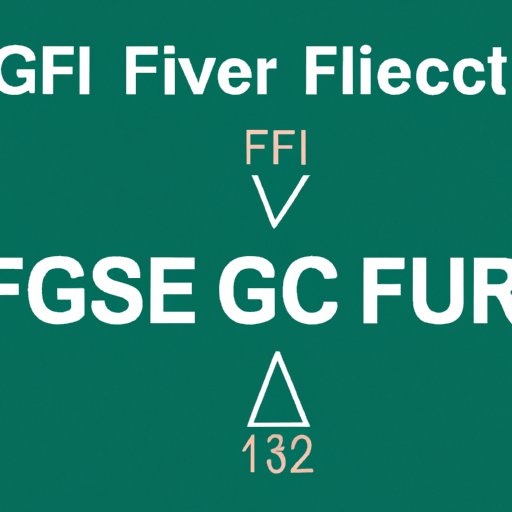
I. Introduction
The Greatest Common Factor, commonly known as GCF, is a crucial mathematical term that plays a significant role in solving complex equations, simplifying fractions, and many other mathematical operations. Whether you’re a student studying math or an adult exploring the world of numbers, understanding how to find the GCF is an essential skill. In this article, we’ll take a comprehensive look at the different methods of finding the GCF of any set of numbers, equations, and polynomials.
II. A Beginner’s Guide to Finding the GCF
Before diving into the nitty-gritty of finding the GCF, let’s first understand what it is. The Greatest Common Factor, simply put, is the highest number that divides two or more numbers without leaving a remainder. To find the GCF, we need to understand the basics of factors and multiples.
Factors are the numbers that divide a particular number without leaving a remainder. For instance, the factors of 18 are 1, 2, 3, 6, 9, and 18. Meanwhile, multiples are numbers that result from multiplying a given number by another integer. A few examples of multiples of 3 are 3, 6, 9, 12, and so on.
Now, let’s explore some common examples of finding GCF by using factors and multiples. Suppose we need to find out the GCF of 24 and 36. We can start by listing all the factors of both numbers and then finding the highest common factor. The factors of 24 are 1, 2, 3, 4, 6, 8, 12, and 24, while the factors of 36 are 1, 2, 3, 4, 6, 9, 12, 18, and 36. The highest common factor between the two is 12, which is the GCF of 24 and 36.
III. Unlocking the Mystery: Simple Techniques for Finding the GCF
There are several methods to find the GCF, but three popular ones are the enumeration, prime factorization, and comparison method.
The enumeration method involves listing all the factors for each number and finding the highest common factor. The prime factorization method involves figuring out the prime factors for each number and taking the product of the common prime factors. Lastly, the comparison method involves comparing the numbers and continuously eliminating their common factors.
Let’s explore these methods through some examples. Suppose we want to find the GCF of 24 and 36 using the enumeration method. We’ll start by listing all the factors of both numbers, which we did previously. Once we have our lists, we can identify the highest common factor, which in this case was 12.
Now let’s try to find the GCF of 36 and 48 using the prime factorization method. We’ll start by breaking down both numbers into their prime factorization. 36 can be expressed as 2 x 2 x 3 x 3, while 48 can be written as 2 x 2 x 2 x 2 x 3. The common prime factors between these two numbers are 2 and 3. To get the GCF, we multiply these common prime factors, giving us a GCF of 2 x 2 x 3, which is 12.
IV. Mastering the Basics: How to Find the GCF in Mathematical Equations
Finding the GCF in mathematical equations can seem like a daunting task, but it’s relatively simple if you understand the basics. Let’s go through the different scenarios where you may need to find the GCF in equations and how to do so.
First, let’s discuss finding the GCF of algebraic terms. Suppose we have an equation 6x + 9. In this case, we can find the GCF of 6 and 9, which is 3, and then factor out the GCF from both terms, giving us 3(2x+3).
Next, let’s look at finding the GCF of polynomials. For example, consider the equation 5x^2 – 10x^3. We can identify the GCF as 5x^2 and then factor it out from both terms, giving us 5x^2 (1 – 2x).
Lastly, let’s explore finding the GCF of fractions. Suppose we want to find the GCF for the fraction 12/15. We can start by finding the GCF for the numerator and denominator, which is 3. Then, we divide both the numerator and denominator by the GCF to get the equivalent fraction, which is 4/5.
V. 3 Easy Steps to Finding the GCF of Any Number
Finding the GCF of any number is easy with the help of these three steps. Here’s what we need to do:
Step 1: Prime factorization of each number.
Step 2: Write the factors of each number in a list.
Step 3: Identify the common factors and multiply them.
Let’s look at an example to understand this method better. Suppose we want to find the GCF of 36 and 48. We prime factorize both numbers, which gives us 2 x 2 x 3 x 3 for 36 and 2 x 2 x 2 x 2 x 3 for 48. Then, we make two lists of factors (2, 2, 3, 3) and (2, 2, 2, 2, 3) and determine the common factors, which are 2, 2, and 3. Finally, we multiply these factors together, getting the GCF of 2 x 2 x 3, which is 12.
VI. Math Hacks: Finding the GCF Made Simple
Sometimes, math hacks can make your life easier. Here are some math hacks for finding the GCF.
The first math hack is to use a calculator to find the GCF. Most calculators come with a GCF function that can save you time. The second hack is to use your fingers to count for the GCF. Simply place your fingers under the numbers and count how many fingers overlap; that’s your GCF.
Let’s explore an example of a math hack. Suppose we need to find the GCF of 36 and 48 using the finger count method. We’ll put our five fingers under 36 and four under 48, and then we’ll count the overlapping fingers, which are four. Hence, our GCF is 4.

VII. Save Time with These Quick Methods for Finding the GCF
The division method and common factor multiplication method are quicker methods to find GCF in larger numbers.
The division method involves dividing the larger number repeatedly by the smaller number until there is no remainder. The last divisor is the GCF. The common factor multiplication method involves multiplying the common factors between the numbers.
Let’s explore an example to understand these methods better. Suppose we want to find the GCF of 120 and 216 using the division method. We’ll first divide 216 by 120, which gives us a quotient of 1 and a remainder of 96. We then divide 120 by 96, which gives us a quotient of 1 and a remainder of 24. After dividing 96 by 24 (a quotient of 4), we end up with 24 as the last divisor, which is the GCF.
VIII. Common Misconceptions and Pro Tips for Finding the GCF Accurately
When it comes to finding the GCF, there are a few common misconceptions and mistakes to avoid. One of the most common misconceptions is that the GCF is always a prime number. While the GCF can be a prime number, it doesn’t have to be.
Here are a few pro tips for finding the GCF accurately. When dealing with fractions, always simplify them before finding the GCF. When dealing with polynomials, you might need to use algebraic methods such as factoring to find the GCF. Lastly, always ensure that you’ve factored out the GCF correctly before proceeding to solve any equation or simplify fractions.
IX. Conclusion
Finding the GCF is a vital mathematical skill that can help you tackle more complex problems with ease. Whether it’s equations, fractions, or large numbers, employing the appropriate method to find the GCF can simplify your problem-solving process. By understanding the different techniques and utilizing math hacks, you can save time and avoid making common mistakes. With practice, you’ll master finding the GCF of any set of numbers in no time.
Recap of major takeaways from the article:
- GCF is the highest common factor between two or more numbers.
- Factors are numbers that divide a number without leaving a remainder.
- The prime factorization method is one of the popular methods used to find the GCF.
- Techniques for finding GCF in mathematical equations include factoring, simplifying fractions, and breaking down polynomials into their GCF.
- The division and common factor multiplication methods are quick ways to find GCF in larger numbers.
- Misconceptions include assuming that the GCF is always a prime number.




